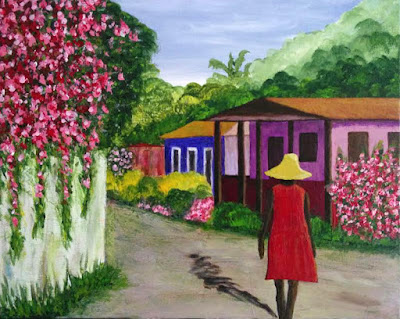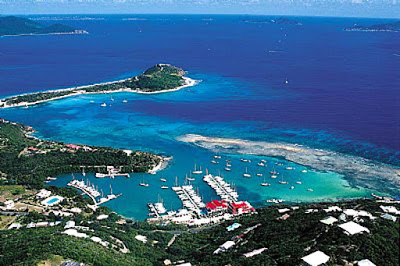 |
| Yellow Tree with Chickens. An art quilt. 12" x 16" |
When we settled in at Tortola, I was thrilled to find a
paperback trading library in Road Town.
For a fee of $5, or a donation of ten paperbacks, a person could become
a member of the library. A fee of 20
cents was charged each time a book was traded.
The library had, maybe, 3000 paperbacks, and the selection was very
good. Over a period of six months, I
traded 65 paperbacks at the library, as well as another score or two with
friends on other boats.
I was rather distressed one day when I visited the offices
where the library had been housed. All
the books were packed away in boxes!
The library had outgrown its home, had been put up for sale, and was
purchased by the Mental Health Society.
I was assured the library would still be open to the public. About a month later, it reopened in another
part of town. Directions to the
location?
Go to the roundabout on the far side of town, cut through
the open market behind it, walk past the first building and turn right, jump
the ditch, (watch out for the chickens!), and walk through the open
doorway.
 |
| Yellow Tree with Chickens. Detail. The yellow chicken is sitting on Snoopy's doghouse. |
The only difference I discerned in using the new library was
that, once you’d traded your books, you were asked if you’d like to make a
donation to the Mental Health Society.
That was a hard one to refuse!
After the move, the library was in a real mess. Books were stacked everywhere on tables and
floor, partly because they didn’t have anyone to shelve them. I talked to a lady there, and offered to put
the paperbacks in order. (My librarian genes kicking in.) They’d just
gotten new shelving. I arranged the
books alphabetically, by author. I had
the project finished after a couple weeks. I
would have hated to see the place close down because there wasn’t anyone to
organize it.
 |
| Yellow Tree with Chickens. Detail. I wove two fabrics together to make the foliage. |
I was
at the paperback trading library one day when I met two heavyset women who were
cleaning the room.
They
asked me, “We been wondrin, is you a
girl or a boy”?
“Girl,”
Between
giggles, they said, “Well, we couldn’t tell; you ain’t got no titties or
nothing”! (I do so have titties….)
I left
the library and was walking along the path when a man came toward me from the
other direction. He looked me up and
down, and then leered with a smile. (At
least someone could still tell I was a girl.)






































